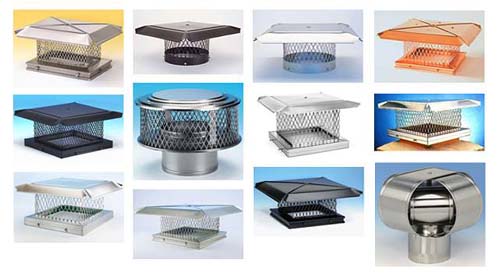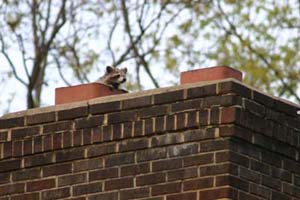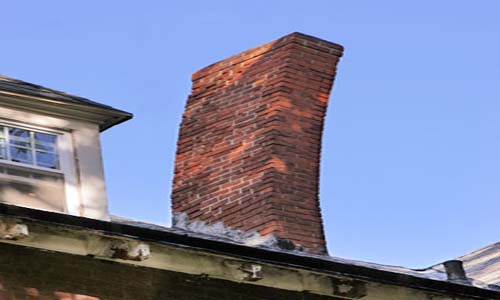No Chimney Cap
February 26, 2015 in No Chimney Cap

A Chimney
cap is more than a decorative
ornament that sits on the top of
your chimney.
It is also a safety feature that
keeps out obstacles such as
smoke and animals from entering
your home. If
your chimney is missing a
chimney cap or the top of the
chimney cap too close to your
chimney end, this could inhibit
your chimney’s draft, which is
what draws air from the
fireplace and allows the fire to
stay light nicely without
allowing smoke to enter your
house. A cap also
keeps out debris such as fallen
leaves, wetness from falling
rain or melting snow, and any
pesky animals such as raccoons
that could try to enter your
chimney.
Water is very destructive to the
interior of your chimney because
it can cause cracks in the
liner.
Another obstacle some chimney
owners face if they have a
double flue chimney is smoke
from the first flue can travel
back down the second flue if a
cap is not there to properly
redirect the smoke.
This can happen from wind
or if the first flue terminates
lower than the second.
The best way to make sure
your chimney cap is operating
properly is to get close and
inspect. You
need to get on the roof and make
sure it is undamaged and
connected properly with the flue
to prevent any fire hazards from
entering your chimney.
If you
determine that your chimney cap
needs to be replaced because it
is damaged, non-existent, or not
connected properly to your
chimney termination, here are
some steps to install a chimney
cap:
1.
Get out your
ladder and climb onto your roof.
2.
Identify the
type of chimney flue that you
have because it will dictate the
chimney cap you can install.
If you are not sure what
type of flue you have, take a
look inside your chimney and
decide which of these
descriptions below that best
matches what you see.
Or, take a picture while
on the roof and bring it to your
computer to compare to the
listed flue types below.
3.
Ok, so the
first step you need to follow is
you need to determine if you
have a masonry chimney or a
factory built prefabricated
chimney.
4.
Then determine
your flue situation and use the
descriptions below as a guide.
At this point, if you
determine that your chimney does
not have a flue, you need to
stop and hire a professional
chimney sweep to install a flue
prior to choosing a new cap.
Your chimney is not
upholding current safety codes
and cannot be used until a flue
is installed first.
5.
Finally, you
can take measurements and decide
on the type of cap that is best
for your chimney. Measure
the inside diameter of your
flue. It is
important to know that the flue
can come in many different
shapes; they can be round, oval,
square or rectangular.
The cap dimensions will
fit these measurements.
6.
If your chimney
is prefabricated, you should
identify the manufacturer and
model information of the pipe at
the same time, if you want a
factory replacement or you have
a metal chimney that requires
it.
7.
When you make
your measurements, take a pencil
and paper with you when you go
up to your roof. Nothing is more
frustrating than winding up with
the wrong size chimney cap
because of a incorrect
measurement.
Measure at least twice to make
sure your measurements are
accurate before you place an
order on a new cap.
This will save you a lot
of work later if you had the
wrong size. If
your chimney system does not
match any of the descriptions
provided in this guide or you're
still unsure of what to measure,
ask a professional chimney
sweep.
a.
Here are
some descriptions of masonry
chimneys and their liners:
i.
Single-Flue
Chimneys with an Extended Flue-
A chimney with a single flue
that extends above its crown.
Extended flues are amongst the
most common and easiest to cap
because the cap can be directly
attached to the flue with clamps
or screws. If you have this type
of chimney all you need to do is
measure the length and width of
the outside of your flue. Then
you can simply search for a
chimney cap designed to fit
those dimensions.
ii.
Single-Flue
Chimneys without an Extended
Flue- The flue in this
chimney is completely flush with
its crown. Capping one of these
chimneys requires either a
standard single-flue chimney cap
with legs or brackets or a
top-mounted model. If you want
to install a chimney cap with
legs or brackets you'll need to
measure the outside width and
depth of your flue. Then, as
when looking for a chimney cap
for an extended flue, you can
search for a model designed to
fit your specifications.
iii.
Single-Flue Chimneys with a
Flexible Metal Liner –
A soft round
metal tube that is flexible and
sits within the chimney.
When capping this kind of
chimney, you have to use a
slip-in model cap. Finding a
chimney cap for this type of
flue is very simple. Just
measure the inside diameter of
your flue and search for a cap
with that diameter.
iv.
Multi-Flue Chimneys-
A chimney that
has more than one flue.
This kind of venting system
requires a top-mounted chimney
cap regardless of whether the
flues are extended or not.
Measuring for a top-mounted cap
that attaches directly to your
crown is more complicated than
the previous models. Start by
measuring the entire length and
width of your chimney. Then
measure the length and width of
the area that contains your
flue. And, finally, measure the
height of each flue.
Depending on your goals, you can
either choose to get a chimney
cap big enough protect your
entire chimney. Or, you can get
one that covers just the area
surrounding your flues.
Regardless of which kind of
coverage you want, your cap must
be at least five inches taller
than your tallest flue.
b. Here are
some descriptions of
Factory-Built Chimneys: In all
cases, it is best to use the
matching cap that is made by the
same manufacturer that designed
your prefabricated chimney because they
highly specialized to work
together.
i.
Double-Wall
Air-Insulated Chimneys-
The double wall chimney has two
pipes within each other.
There is an inner pipe and an
outer pipe separated by open
space that allows air flow to
cool the flue. Because they are
so specialized, it's best to use
a chimney cap produced
specifically for your brand of
double-wall air-insulated vent
pipe. The diameter of the
chimney cap you choose needs to
be the same as your pipe's inner
diameter; a pipe with a
seven-inch inner diameter, for
example, requires a seven-inch
chimney cap.
ii.
Double-Wall
Solid-Pack Insulated Chimneys -
Double-wall solid-pack insulated
chimneys also feature an inner
and outer wall, but rather than
air, it uses insulation to
separate the two pipes. In some
instances the insulation is left
exposed, while in others it is
covered with a metal cap. Both
varieties require a chimney cap
specifically designed for that
type of double-wall solid-pack
insulated pipe. As with
air-insulated models, it's best
to use a cap produced by the
same manufacturer as your pipe.
iii.
Triple-Wall
Air-Insulated- These
work just like double-wall
air-insulated pipes and require
a specialized triple-wall
chimney cap made by the same
manufacturer.
iv.
Triple-Wall
Solid-Pack Insulated Chimneys -
Triple-wall solid-pack insulated
pipes feature three walls
separated by insulation. This
kind of chimney requires a cap
specifically designed for
triple-wall insulated pipe and,
as with other types of metal
chimney pipes, it's best to use
the one produced by the same
manufacturer. Even though
these chimneys have three walls,
you only need to know the
diameter of the inner and
outermost ones. Your pipe's
inner diameter is the number you
need to match when selecting a
chimney cap; a pipe with a
six-inch inner diameter, for
example, requires a six-inch
chimney cap. The outer wall of
your pipe also needs to be
covered by your cap, but it
doesn't matter if your cap
extends beyond the edges of your
pipe.
Now that you have determined the type and size of chimney cap that you need, you can place your order. Once it arrives, you can install it by screwing it in or if it not the type that screws in; inserting it and applying a silicone sealer.



